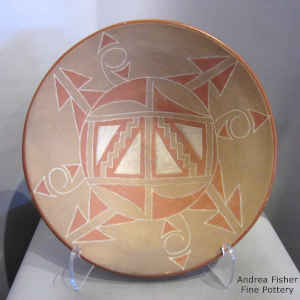San Juan Pueblo - Ohkay Owingeh
- Ohkay Owingeh: Village of the Strong People
- Language: Tewa
- Size: 12,230 Acres
- Population: 2000
About 30 miles north of Santa Fe, New Mexico, San Juan Pueblo has been continuously inhabited for more 700 years, and more than 100 of its original buildings still survive.
The Spaniard Don Juan de Onaté arrived at the pueblo on an exploration survey in 1598. Impressed by the friendly people he met, he christened the pueblo San Juan de Caballeros (Saint John of the Gentlemen) and decided the pueblo would serve well as the first capital of Spanish Nuevo Mexico.
The capital at San Juan lasted ten years, then the Spanish governor ordered the capital be moved to an uninhabited area to the south in 1608. That new capital was later named "La Villareal de la Santa Fe de San Francis de Assisi" (The Royal City of the Holy Faith of St. Francis of Assisi, later shortened to Santa Fe).
Popé, an important leader during the Pueblo Revolt of 1680 was from San Juan. Popé was a traditional pueblo medicine man and he was flogged by the Spanish authorities for performing traditional religious ceremonies.
In the late 1670s, he and leaders from other pueblos began to organize a rebellion against Spain. When the Spanish were informed of the plan by an informant, Popé took refuge at the pueblo of Taos where he finished his plans and then put those plans into action.
The revolt took place simultaneously in all of the Pueblos except Isleta and Hopi (the Hopi threw the Spanish out shortly after while most of Isleta sided with the Spanish, many even retreating south with them to found the pueblo of Ysleta del Sur near El Paso). Spanish settlers and priests were killed and churches burned. The Spaniards that survived fled to Santa Fe and took refuge in the Palace of the Governors.

The Chapel of Nuestra Senora de Lourdes at Ohkay Owingeh
The pueblo warriors followed them and laid siege to the Palace after cutting off their water supply. When the Spaniards decided to leave the Palace, the warriors let them go peacefully but followed them closely as they retreated south down the Rio Grande Valley to the El Paso area. The Spaniards returned to San Juan in 1692 with Don Diego de Vargas leading his Conquistadors, and they re-conquered New Mexico.
San Juan Pueblo today has two churches: the Chapel of Nuestra Senora de Lourdes was built of cut stone in 1898 while the red brick San Juan Bautista church was built in 1913. San Juan is home to the Bureau of Indian Affairs' Northern Pueblos Agency. It also houses the Eight Northern Indian Pueblos Council, which coordinates many programs including education, health, social services and economic development among the northern pueblos.
San Juan Pueblo officially changed the pueblo name to Ohkay Owingeh (Place of the Strong People) in 2005, although there was considerable push-back from the US Postal Service. As for those of us ensconced in the pottery world, we're left with so many things signed with "San Juan Pueblo."
Pottery History
Pottery from San Juan has long been prized as sturdy utilitarian ware. Even during the Spanish occupation, many Hispanic households in northern New Mexico used it regularly due to its durability.
Before 1890, San Juan pottery was either red or black and usually undecorated. However, pottery production was almost completely stopped by 1900. The 1910 census showed only two potters, Crucita Trujilo and Juanita Torres, still making pottery. By contrast, in 1940, nine years after the San Juan pottery revival officially began, there were 59 people identifying themselves as potters.
In the 1930s Regina Cata, a Spanish woman who had married into the pueblo, introduced a new style of pottery. Regina had married Eulogio Cata, Governor of San Juan Pueblo at the time. Regina worked at the San Juan Day School back then.
Regina organized a group of potters, including Crucita Trujillo, Reycita Trujillo, Crucita Talachy (Atencio), Gregocita Cruz, Luteria Atencio, Crucita Cruz and Tomasita Montoya, to study ancient Potsuwi'i incised pottery shards dating from around 1450-1500. The shards had been discovered in an abandoned, unexcavated ancestral village of the San Juan people, across the Rio Grande from the current pueblo but still on San Juan Pueblo land.
Those potsherds were used as a basis for a contemporary San Juan pottery type. Decorative zones of tan with geometric fine lines and selected areas of polished red slip were the final result of that decision.
The new San Juan pottery style consists mostly of red and tan ware and is heavier than previous San Juan pottery. The rim and base of the pots are usually polished red with an unslipped, buff-colored band in between. The band is either carved and decorated with red, buff and white matte paints or incised with a micaceous slip applied in the grooves, before firing. Typical designs include geometric patterns, flowers, feathers, kiva steps, spirals, rainbows and sun/cloud patterns.
As the original eight women slowly passed away, that revival slowly petered out through the 1940s and 50s, only to be revived again in the 1970s. Only this time, the pottery became even more beautiful as the artists worked to keep up with what was happening at Santa Clara and San Ildefonso at the time.
Tomasita Montoya (1889-1978) was the longest lived of the original eight and she was the most prolific of the group. She was alive long enough to see the second renaissance happen but we're now at a point in time when there are very few potters at Ohkay Owingeh.

San Juan Bautista Church at Ohkay Owingeh



